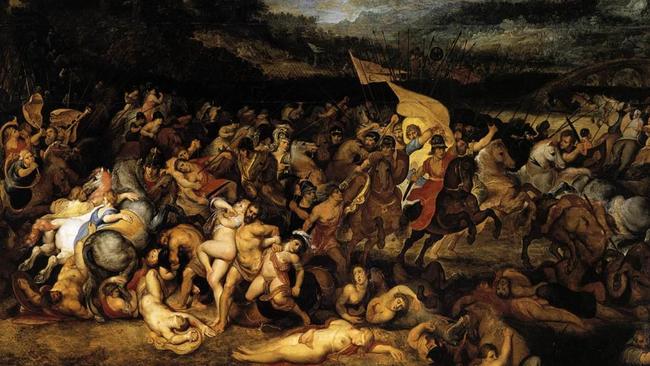John Man digs deep for the legendary Amazons: The Real Warrior Women
When Achilles saw the queen of the Amazons, he instantly fell in love. You can see why.

When Achilles saw the queen of the Amazons, he instantly fell in love. You can see why. Penthesilea had everything: courage, flashing eyes, a ravishing smile and, if the statues are to be believed, a laissez-faire way with shoulder straps. One breast is almost always popping out.
There was just one problem: she also had a spear through her heart, and it was he who had put it there. Penthesilea had approached on horseback in full armour and he speared both her and horse in one. When he took her off he realised what he had done, but it was too late. She quivered and died “like meat on a spit”. Achilles, ruing that he had caused an actual mort rather than la petite, grieved bitterly.
She deserved his tears: being an Amazon in ancient times was, even at its best, a bit of a mixed bag. On the bright side you escaped the dreary fate of a Greek wife (weaving, women’s quarters, husbands who were fonder of pederasty than of you). Less pleasingly you had a life of relentless hardship, a high chance of getting killed in battle and an even higher chance of being immortalised in bad Victorian art.

And perhaps worst of all, you didn’t exist. As John Man explains in Amazons: The Real Warrior Women of the Ancient World, tales of such a fearsome tribe arose “in the dream-time before written records”. For centuries in Greece there were whispers of a wild people who rode horses, lived near the Black Sea and were happy to be propositioned by Greek men — but not proposed to by them.
It was said they killed all boys at birth. Herodotus recorded how when one man asked his Amazon lover to marry him, she told him where to go. “Your women stay at home in their wagons occupied with feminine tasks,” she said. “We could not possibly agree.”
So appealing — or perhaps appalling — was this myth that ever since people have obsessed about Amazons, told stories about them, written plays about them and tried to find them. They are the Atlantis of humanity. Traces of the tribe can be found everywhere from Homer to Wonder Woman, while their name has been bequeathed to everything from the greatest river in South America to one of the largest companies in the world.
Like Atlantis, they have never been found. The whole notion started to be discredited. Herodotus, who was once the “Father of History”, became in less reverent times the “Father of Lies” and his fantastic Amazons were demoted to myth. Wrongly, says Man. Because while there was no nation of women, recent archeological digs have shown that in many different ways “Herodotus had been right”.
To understand how right you have to travel to the edges of the old Soviet Union, to burial places in Ukraine and the edge of Mongolia. Because if there is any truth in the Amazon legend, then it lies in the Scythian and Sarmatian graves to be found here. In Ukraine in a 4th-century BC grave, one woman was buried with iron lance points and arrows in a feathered quiver. Another woman in a 7th-century BC grave in Tuva was buried in a gold cap decorated with a panther and (less ferociously) a wooden ladle with a golden handle. Perhaps even Amazons liked cooking occasionally.
And in many of these graves there was gold. Masses and masses of gold. Gold brooches, gold panthers, gold beads. When a chink was opened in one 5th-century BC Kazakh tomb the excavators saw the yellow gleam within and instantly hired two locals to stand guard overnight. This being the former Soviet Union, it was a chilly night. This being the former Soviet Union, the guards’ solution to this creepy task was to pop out and buy some fortifying vodka. When they came back, the best pieces had gone.
The women in these graves were admittedly not quite Herodotus’s man-child murdering, lover-taking viragos — they lived with men — but they were pretty damn close. They were more European than Mongol. They were evidently excellent horsewomen and they were obviously warriors: they had been given burials like those of men and had wounds to match.
A list of injuries from graves in the Republic of Tuva, near Mongolia, makes grim reading. Like the endless battle scenes in Homer, in which warriors are paused forever at the moment of their grisly ends, so these people are perpetually frozen at the point of death. Some have been beheaded. Several have damaged left arm bones “as if they had held up that arm to ward off blows”. One Scythian woman has a broken finger bone, suggesting, as Man says, “that she gave as good as she got”. As he observes, mutedly: “Horse-based cultures are tough for everyone.”
Despite the grim reality of Amazon life, salacious rumours spread. One of the most persistent was that they cut off or cauterised one breast to better be able to draw back the string of their bows. Hence, it was said, their name: mastos in Greek is breast; a-mastos is without a breast. “Balderdash,” says Man. It’s a false etymology; a-mastos is not A-mazon and “anyone watching the 2016 Olympics could see that women archers … are not impeded by breasts”.
Nevertheless, the ideal of such women who could and did live perfectly well without men had taken hold. Roman sculptors carved them; Rubens immortalised them; feminist Enlightenment playwrights wrote stirring five-part dramas about them. Less-than-feminist Enlightenment critics sneered.
Then some classically educated conquistadors, exploring a vast river in South America, sought a suitably fierce name for the area and its frightening inhabitants and, in the pages of Herodotus, found it. The Amazon was born.
Then, in 1994, came what is perhaps now the most famous linguistic conquest of all. A young entrepreneur was searching for a name for his new business. He wanted this company to sell everything. He wanted its name to be early in the alphabet “to make sure it came up quickly on internet browsers”. “Aard.com” wasn’t quite right. Nor was “Awake.com”. Then in late October Jeff Bezos was leafing through the “A” section of the dictionary and …
The rest is history. Or history of sorts. This book is tremendously entertaining but there are moments when it feels constructed less around an argument and more after a word-association game. Or possibly a quick Google. In the opening of one of the later chapters, Man, who has written popular histories of Genghis Khan and Saladin, observes that “there’s no shortage of warrior women. Websites list them by the score.” Well, yes, they might, but books demand — or should demand — higher standards.
At times it seems that being female and fierce is enough to qualify for a chapter here. So in a book ostensibly about “the real warrior women of the ancient world”, you get a chapter on Russia’s night witches, the “aviatrixes” who flew daring raids in World War II. Sometimes the women are not even that fierce; one chapter dips into a riding school in Hemel Hempstead in Hertfordshire. What would Penthesilea say? Then again, being an ancient warrior and aware of the joy of fame, she probably would appreciate the publicity nonetheless.
Catherine Nixey is author of The Darkening Age: The Christian Destruction of the Classical World.
THE TIMES
Amazons: The Real Warrior Women of the Ancient World
By John Man
Bantam, 320pp, $44.99 (HB), $34.99 (PB)


